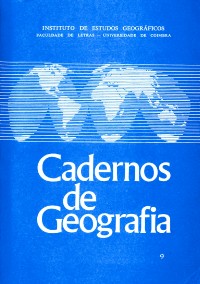Please use this identifier to cite or link to this item:
https://hdl.handle.net/10316.2/40565| DC Field | Value | Language |
|---|---|---|
| dc.contributor.author | Cordeiro, A. M. Rochette | - |
| dc.date.accessioned | 2016-12-16T12:30:38Z | |
| dc.date.accessioned | 2020-09-22T12:44:08Z | - |
| dc.date.available | 2016-12-16T12:30:38Z | |
| dc.date.available | 2020-09-22T12:44:08Z | - |
| dc.date.issued | 1990 | - |
| dc.identifier.issn | 0871-1623 | - |
| dc.identifier.issn | 2183-4016 (digital) | - |
| dc.identifier.uri | https://hdl.handle.net/10316.2/40565 | - |
| dc.description.abstract | Os processos morfogenéticos do Tardiglaciar würmiano têm, até ao momento, sido considerados como os grandes responsáveis por uma importante dinâmica de vertentes, da qual resultaram, entre outros, grandes depósitos heterométricos de características solifluxivas. Com o início do estudo do depósito de Varzielas, na Serra do Caramulo (lat. 40° 34' Norte), e a datação a C14 da base de um nível intermédio de paleossolo (15550 BP), uma nova perspectiva nos aparece para a compreensão da dinâmica de vertentes, vegetação e clima da transição do Pleniglaciar superior para o Tardiglaciar e em especial deste ûltimo. Terá assim começado a sequência tardiglaciar com o aparecimento de condições climáticas propícias ao desenvolvimento da pedogénese, bem como a conquista por parte da vegetação, dos solos anteriormente gelados. Posteriormente (Dryas recente ?) existe na fachada ocidental de Portugal uma recorrência das condições climáticas frias e secas capazes de reduzir ao mínimo a vegetação e de provocar um novo aparecimento dos depósitos heterométricos de características solifluxivas. | por |
| dc.description.abstract | Les processus morphogénétiques du Tardiglaciaire würmien furent, jusqu'à présent, tenus comme étant les principaux responsables d'une grande dynamique de versants, dont découlèrent, entre autres, de grands dépôts hétérométriques aux caractéristique solifluxives. Avec le début de l'étude du dépôt de Varzielas, dans la Serra do Caramulo, (lat. 40° 34' nord), et la datation au C.14 de la base d'un niveau intermédiaire de paléosol (15550 BP), une nouvelle perspective apparaît pour la compréhension de la dynamique de versants, végétation et climat de la transition entre le Pléniglaciaire et le Tardiglaciaire, en particulier de ce dernier. La séquence Tardiglaciaire aurait ainsi commencé avec l'apparition de de conditions climatiques propices au développement de la pédogénèse, tout autant que par la conquête par une partie de la végétation des sols antérieurement gelés. Postérieurement (Dryas recent ?), il existe sur la façade occidental du Portugal une réapparition des conditions climatiques froides et sêches propres à réduire au minimum la végétation et à provoquer une nouvelle apparition des dépôts hétérométriques aux caractéristiques solifluxives. | fra |
| dc.description.abstract | Until now, the morphogenetic processes of the date würm period have, been considered the sole cause of an important slope dynamics that, has originated certain types of deposits, including big heterometrical deposits of a solifiuxive character. With the beginning of the study of the Varzielas deposit in Serra do Caramulo (40° 34' north) and the 14 C dating of the base of an intermediate level of palaeosol (15000 BP), a new perspective emerges for the understanding of slope dynamics of the vegetation and as well as climate of the transition stage from the upper Pleniglacial to the Tardiglacial and specially of the latter period. Thus, the Tardiglacial sequence must certainly have started with the appearance of the proper climate conditions - that is, conditions that would favour both the development of the pedogenesis and the conquest, by the vegetation, of previously frozen soils. At a later stage (recent Dryas?), there exists in Portugal's western façade a recurrence of the cold and dry climate conditions that are able to reduce the vegetation to a minimum and to cause a new appearance of the heterometric deposits of the solifluxive type. | eng |
| dc.language.iso | por | - |
| dc.publisher | Faculdade de Letras da Universidade de Coimbra | - |
| dc.rights | open access | - |
| dc.title | O depósito de Varzielas (Serra do Caramulo): contribuição para o estudo do Tardiglaciar würmiano em Portugal | por |
| dc.type | article | - |
| uc.publication.collection | Cadernos de Geografia nº 9 | - |
| uc.publication.firstPage | 49 | - |
| uc.publication.issue | 9 | - |
| uc.publication.lastPage | 60 | - |
| uc.publication.location | Coimbra | - |
| uc.publication.journalTitle | Cadernos de Geografia | - |
| dc.identifier.doi | 10.14195/0871-1623_9_3 | - |
| uc.publication.orderno | 3 | - |
| uc.publication.area | Ciências Sociais | - |
| uc.publication.manifest | https://dl.uc.pt/json/iiif/10316.2/40565/233817/manifest?manifest=/json/iiif/10316.2/40565/233817/manifest | - |
| uc.publication.thumbnail | https://dl.uc.pt/retrieve/11484660 | - |
| item.grantfulltext | open | - |
| item.fulltext | With Fulltext | - |
| Appears in Collections: | Cadernos de Geografia | |
Files in This Item:
| File | Description | Size | Format | |
|---|---|---|---|---|
| o_deposito_de_varzielas.pdf | 2.76 MB | Adobe PDF |  |
Items in DSpace are protected by copyright, with all rights reserved, unless otherwise indicated.
